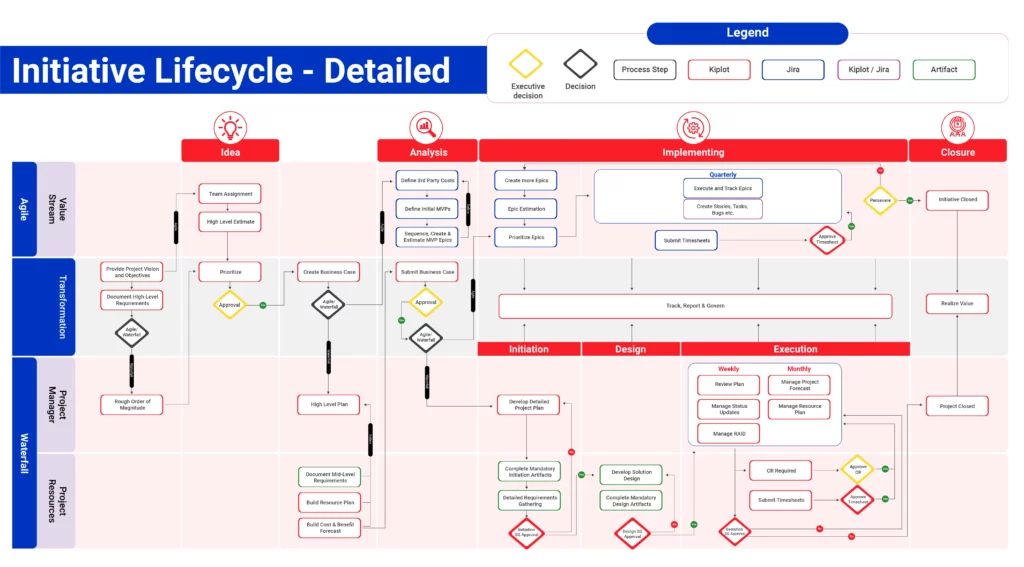Introduction
Excessive approval workflows are a quiet but persistent drag on delivery at large organizations. Each additional checkpoint delays progress, disrupts workflows, and frustrates teams – yet these layers of control often fail to deliver the oversight they’re intended to provide. In many enterprise organizations, traditional approval-heavy processes are more liability than solution.
The way forward lies in replacing rigid approval chains with adaptive guardrails – systems that monitor adherence to thresholds and enable autonomy without sacrificing governance. By eliminating unnecessary approvals and delegating authority where possible, organizations can strike a precise balance between agility and control.
This article explores how organizations can reduce their reliance on approvals by adopting guardrails – lightweight governance mechanisms that empower teams to act with autonomy while ensuring key approvers retain oversight of critical decisions.
Why approvals are slowing your organization down
Approvals, in their traditional form, are designed to ensure control and alignment. But as organizations scale, these processes become bloated. Each approval step adds friction. Limiting the autonomy of teams and eroding the speed at which value can be delivered.
Excessive approvals have hidden costs
- Delays that cascade: A delayed approval for one initiative stalls progress on dependent projects, compounding inefficiencies across the portfolio.
- Decision fatigue: Overloading key approvers with routine approvals detracts from their ability to focus on higher-value strategic initiatives.
- Eroded accountability: When every decision requires sign-off, teams become reliant on approvals rather than empowered to act within clear guidelines.
Guardrails as an alternative to approvals
The solution is not to optimize approval-heavy workflows but to eliminate them wherever possible.
Guardrails offer a lighter, more adaptive approach to governance, enabling decisions to flow freely while monitoring for breaches of predefined thresholds.
What are guardrails? Guardrails are predefined thresholds or boundaries that allow teams to make decisions autonomously while triggering interventions only when necessary.
For example:
- A team might proceed with initiatives under a $50,000 budget threshold without approvals.
- Automatic escalation occurs only when spending exceeds that limit or violates organizational policies.
Why guardrails work: Guardrails provide proactive monitoring rather than reactive control, enabling organizations to scale governance without introducing bureaucracy. They create systems of trust and accountability while maintaining strategic oversight.
💡 Guardrails are a practical, accessible framework that any enterprise can adopt, regardless of where they are in their governance evolution. Just because your organization is at the start of its Agile transformation, or hasn’t yet reached maturity in it’s Agile practices, it doesn’t mean you can’t establish lightweight, effective governance systems that enable autonomy while maintaining control.

How to implement guardrails without sacrificing control
Transitioning from approval-heavy workflows to guardrails requires a deliberate approach. The goal is to create systems that enable agility while maintaining governance – not by increasing oversight but by shifting how it is applied.
1. Establish clear thresholds for decision-making
Guardrails begin with defining the boundaries within which teams can operate without needing approvals. These thresholds should reflect the organization’s strategic priorities and risk tolerance.
Example thresholds:
- Financial: Projects under $50,000 may proceed without executive review.
- Risk: Initiatives categorized as “low-risk” can bypass multiple layers of governance.
- Timeline: Routine decisions that do not impact critical delivery dates can be delegated to team leads.
Practical step: Review historical data to determine where delays typically occur and align thresholds with organizational goals and risk tolerance. For instance, projects with minimal variance in approval times are candidates for reduced oversight.
2. Automate monitoring and intervention
Guardrails rely on continuous monitoring rather than manual intervention. Automation ensures that the system flags exceptions or breaches dynamically, enabling teams to move quickly while escalating only when necessary.
How to implement:
- Use portfolio management software such as Kiplot to monitor adherence to thresholds.
- Configure automated alerts for breaches, such as exceeding financial limits or deviating from approved timelines.
Why this matters: Automation minimizes manual intervention, enabling approvers to focus on strategic priorities rather than chasing approvals. This not only saves time but also builds trust among teams.
3. Delegate authority strategically
Delegation shifts responsibility for routine decisions to those closest to the work while maintaining oversight for key initiatives.
How to delegate effectively:
- Develop a governance matrix that defines decision-making authority based on role, project scope, and risk.
- Train teams to operate within their delegated authority, ensuring they understand the limits and expectations of their role.
Practical focus: Delegation requires transparency. Establish mechanisms for tracking delegated decisions, ensuring they align with broader organizational objectives.
Balancing agility and control with guardrails
Guardrails succeed not by removing oversight but by redefining it. The balance between agility and control lies in enabling teams to work within clearly defined boundaries while ensuring leaders retain visibility into strategic decisions.
1. Monitor outcomes, not processes
Traditional approval workflows focus on individual decisions, but guardrails shift the focus to results. Leaders monitor whether teams are achieving desired outcomes within the defined boundaries, rather than micromanaging each step.
How to implement:
- Use metrics aligned with strategic goals, such as budget adherence, delivery timelines, or quality benchmarks, to assess performance.
- Utilize dashboards that provide a portfolio-wide view of outcomes without requiring manual updates or status reports.
Why this matters: Outcome-based monitoring reduces unnecessary interventions while ensuring teams remain accountable for delivering value.
2. Employ proactive risk management
Guardrails rely on risk management that identifies potential issues before they escalate, replacing reactive approval cycles with predictive oversight.
How to implement:
- Leverage predictive analytics to flag risks, such as timeline slippage, resource constraints, or budget overruns, before they breach thresholds.
- Pair automated alerts with contingency plans that allow teams to adjust autonomously when risks materialize.
Practical focus: Guardrails don’t eliminate the need for leadership involvement; they focus it on high-value interventions, ensuring governance resources are spent where they’re needed most.
3. Adjust guardrails as your portfolio evolves
No governance system is static. As portfolios grow in complexity, guardrails must adapt to reflect shifting priorities, new risks, and changing organizational goals.
How to implement:
- Schedule quarterly reviews of guardrail thresholds to ensure they remain aligned with portfolio demands.
- Engage stakeholders during reviews to gather insights from those directly affected by the guardrails.
Practical focus: Treat guardrail refinement as a continuous process, incorporating data and feedback to ensure the system remains agile and effective.
Conclusion
Excessive approvals are a symptom of governance systems designed for another era – systems that prioritize control over agility. For enterprise organizations aspiring to operate with agility governance must evolve to balance both. Guardrails offer a contemporary solution: they replace reactive approvals with proactive boundaries, enabling decisions to flow freely while ensuring alignment with strategic objectives.
The question isn’t whether approval-heavy processes should change – it’s whether your organization is ready to lead the shift to guardrail-driven governance.

